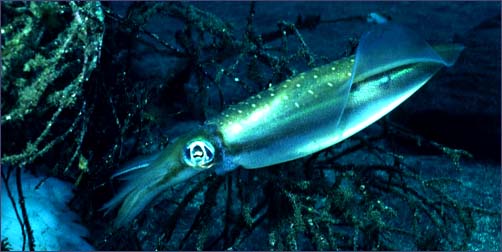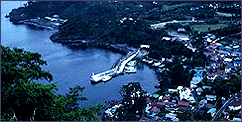
|
No. 18 Twigs for the Aoriika squid in Jogasaki, Izu. |

|
No. 18 Twigs for the Aoriika squid in Jogasaki, Izu. |

|
|
|
A female Aoriika squid depositing her eggs on a twig. |
|
|
Aoriika, a big fin reef squid in English, is a medium size squid that grows to 40-50cm in length. It can be found off all the shores south of Hokkaido. Unlike the Yariika squid, they do not form large schools. A group of 20-30 Aoriika is often found in the middle depths off most coastlines. Because its meat is tender and quite delicious, it commands a high price in the market.
In the Izu area, from mid May to early October, you can see the Aoriika spawning on the seabed by laying its eggs in clusters. Rather than simply spawning on the flat seabed, they often lay their eggs on seaweed or creatures that provide adhesive surfaces. This is probably in order to have the eggs surface evenly in the water and not have it suffocated by sand and grime. I was first able to see the Aoriika about 12 or 13 years ago when I was shooting in the Izu seabed. The squid were just beginning to spawn on an iron basket on the sea bottom. Their reproductive behavior is as follows. At a spot a little distance from the spawning ground, the male inserts its genital arm into the female mantle. It then passes a capcell with spermatozoon with the tip of his arm. The female places the spermatozoon on her eggs and deposits her eggs in clusters. As we approached, the Aoriika that first placed themselves at some distance seemed to like the iron basket and after a while, they came back very close to us again. There were the brave female squid driven by the basic instinct to spawn. The male squid were escorting the females with their ulterior motive to take advantage of the next opportunity for intercourse. The love games of courting and fighting among the males were played out in front of my eyes. Their expressions and beauty fascinated me. These pictures were broadcast on TV. The unique ecology and rich looks of a creature we typically associate as foodstuff, became the topic of conversation. A few years later, the fishermen of Futo, a small fishing town in Jogasaki, Izu, began to place twigs cut from the nearby woods in the seabed. The twigs were sunk as objects for the Aoriika to spawn on. The results far surpassed expectations and the Aoriika nearby spawned continuously. The twigs that vastly increased their spawning area delighted the Aoriika squid, which used to spawn on the limited number of object on the seabed. The squid were the happiest. Next happiest were the divers. Hearing that they could observe first hand, the Aoriikas spawning that they had been able to watch on TV or tape, many divers rushed to the town of Futo. Since then, this small fishing village has become famous as one of the best diving spots in Japan for observing the marine creature's ecology. The fishermen's experiment began as a way to drive increasing numbers of Aoriika squid into their stationary nets. It ended up introducing many a people to the ecology and attraction of a marine creature, the Aoriika, which has only been associated as a thing to eat. If I may be allowed a slight exaggeration, it gave me a new perspective on the relationship between the squid and man as creatures born to this earth.  Men had eaten the squid only to fill their stomachs. After seeing how they live, man started to contemplate how life ought to be and began to realize that it is time to reconsider the nature of life. Men had eaten the squid only to fill their stomachs. After seeing how they live, man started to contemplate how life ought to be and began to realize that it is time to reconsider the nature of life.
|
|
The town of Futo in Jogasaki, Izu, is one of the best diving spots in Japan to observe the ecology of marine creatures. |
|
|